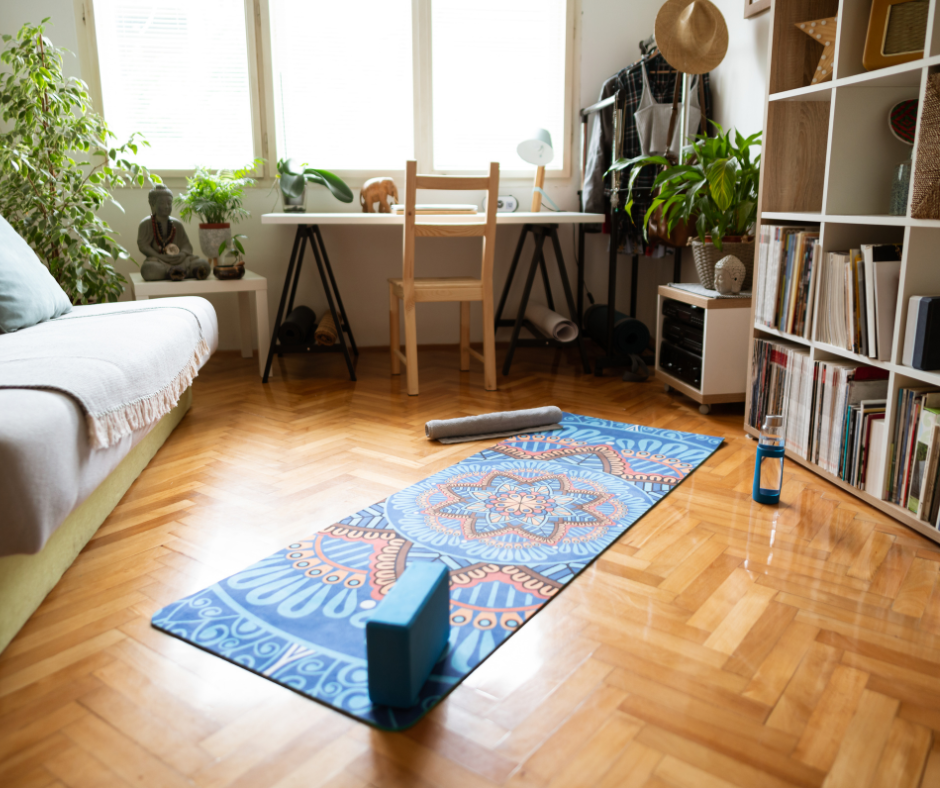
Creating a dedicated space for yoga in your home can elevate your practice, deepen your connection to mindfulness, and provide a sanctuary for relaxation. Whether you’re new to yoga or looking to enhance your practice, designing a home yoga space doesn’t have to be complicated or expensive. Here are some beginner-friendly tips to help you create the perfect setup.
1. Choose the Right Location

Finding the ideal spot in your home is the first step. Look for a space that is:
- Quiet: Away from heavy foot traffic or noisy appliances.
- Spacious: Enough room to stretch out fully without feeling cramped.
- Well-lit: Natural light creates a calming ambiance, but soft artificial lighting can also work.
- Ventilated: Fresh air helps maintain a peaceful atmosphere.
Even a small corner of a room can work if you’re short on space. The key is to choose an area where you feel comfortable and focused.
2. Keep It Minimalist

Clutter can be distracting. Keep your yoga space simple and tidy. Consider:
- Storage Solutions: Use baskets or shelves for yoga mats, blocks, and props.
- Decor: Add calming elements like a plant, a candle, or a small piece of art.
- Colors: Neutral or earthy tones can help create a serene environment.
3. Invest in Basic Equipment

For a functional yoga practice, you’ll need some essential items:
- Yoga Mat: Choose a mat with good grip and cushioning.
- Props: Blocks, straps, and bolsters can support your practice, especially if you’re a beginner.
- Blanket: Useful for seated poses or relaxation.
Look for eco-friendly options to align with yoga’s values of sustainability and mindfulness.
4. Set the Mood

Enhance the ambiance of your yoga space with:
- Sound: Play soothing music or nature sounds.
- Scent: Use essential oils, incense, or a diffuser to create a relaxing aroma.
- Lighting: Dim lights or candles can promote relaxation during evening sessions.
5. Personalize Your Space

Your yoga space should reflect your personality and inspire your practice. Add elements that resonate with you, such as:
- A vision board or inspirational quotes.
- Crystals or spiritual items, if they’re part of your practice.
- A dedicated space for meditation, such as a cushion or meditation chair.
6. Maintain Cleanliness
A clean space is a clear space. Regularly:
- Wipe down your yoga mat.
- Dust and vacuum your yoga area.
- Keep props organized.
7. Make It Tech-Friendly (Optional)
If you follow online classes or tutorials, consider:
- Placing your device at eye level for easy viewing.
- Using a stand or wall mount for hands-free access.
- Ensuring a stable internet connection for live sessions.
8. Establish a Routine

Consistency is key to reaping the benefits of yoga. Having a designated space can help you:
- Stay motivated to practice regularly.
- Transition easily into a mindful state.
- Build a habit that integrates seamlessly into your lifestyle.
Conclusion
Building a home yoga space is an investment in your well-being. By creating an environment tailored to your needs and preferences, you’ll cultivate a practice that’s both fulfilling and sustainable. Remember, the most important thing is to make your space a reflection of your yoga journey. Start small, and as your practice evolves, so can your space.
Looking for more yoga tips or inspiration? Follow Soul Appeal Wellness on Instagram for expert guidance and resources to enhance your yoga journey!
